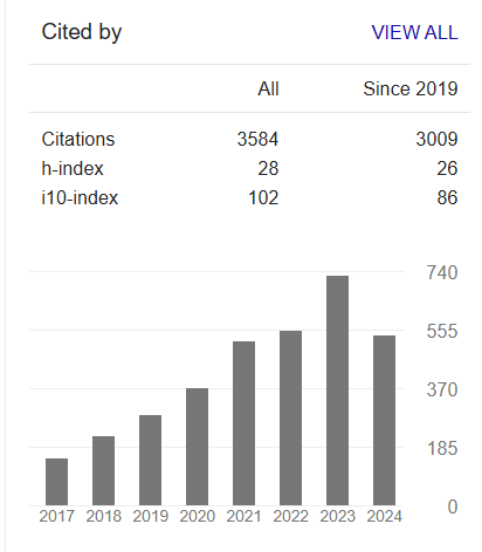Kajian Senyawa Metabolit Sekunder pada Mentimun (Cucumis sativus L.)
Wiwit Yuni Astuti(1), Dyah Weny Respatie(2*)
(1) Departemen Budidaya Pertanian, Fakultas Pertanian, Universitas Gadjah Mada
(2) Departemen Budidaya Pertanian, Fakultas Pertanian, Universitas Gadjah Mada
(*) Corresponding Author
Abstract
Keywords
Full Text:
PDFReferences
Agatemor, U. M., O. F. C. Nwodo, and C. A. Anosike. 2018. Phytochemical and proximate composition of cucumber (Cucumis sativus) fruit from Nsukka, Nigeria. African Journal of Biotechnology. 17(38): 1215-1219
Ahmed, E., M. Arshad, M. Z. Khan, M. S. Amjad, H. M. Sadaf, I. Riaz, S. Sabir, N. Ahmad, and Sabaoon. 2017. Secondary metabolites and their multidimensional prospective in plant life. Journal of Pharmacognosy and Phytochemistry. 6(2):205-214
Aniekwe, N. L., and Anike, N. T. 2015. Effect of different mulching materials and plant densities on the environment, growth, and yield of cucumber. Journal of Agriculture and Veterinary Science. 8(11): 64-72
Ashok, P. K., and K. Upadhyaya. 2012. Tannins are astringent. Journal of Pharmacognosy and Phytochemistry. 1(3):45-50
Badan Standarisasi Nasional Indonesia, 2013. Standar Nasional Indonesia : Mentimun. www.bsn.go.id diakses pada 22 Maret 2020
Badan Pusat Statistik, 2019. Statistik Tanaman Sayuran dan Buah-buahan Semusim. www.bps.go.id diakses pada 11 Maret 2020
Bassoli, A., G. Borgonovo, and G. Busnelli. 2007. Alkaloid and The Bitter Taste. In: Fattorusso, E., and O. Taglialatela-Scafati (Eds.). Modern Alkaloids – Structure, Isolation, Synthesis and Biology. WILEY-VCH Verlag GmbH & Co. KGaA, p: 53-72
Devandra. N. K., E. G. Attard, D. Raghunandan, and Y. N. Seetharam. 2011. Study on seasonal variation on the content of cucurbitacin of various vegetative parts of Trichosanthes cucumerina L. var. Cucumerina. International Journal of Plant Research. 1(11): 25-28
Dong, Y., B. Lu, X. Zhang, J. Zhang, L. Lai, D. Li, Y. Wu, Y. Song, J. Luo, X. Pang, Z. Yi, and M. Liu. 2010. Cucurbitacin E, a tetracyclic triterpenes compound from Chinese medicine, inhibits tumor angiogenesis through VEGFR2-mediated Jak2-STAT3 signaling pathway. Carcinogenesis. 31(12): 2097-2104
El Barky, A. R., S. A. Hussein, A. Alm-Eldeen, Y. A. Hafez, and T. Mohamed. 2017. Saponins and their potential role in diabetes mellitus. Diabetes Management. 7(1):148-158
Enslin, P. R. 1954. Bitter principles of the Cucurbitaceae. I. Observations on the chemistry of cucurbitacin A. Journal Science Food Agriculture. 8: 673 - 678
Harborne, J. B. 1998. Phytochemical Methods. A Guide to Modern Technology of Plant Analysis, 3rd Ed. Chapman and Hall, New York.
Hu, C., H. Zhao, W. Wang, M. Xu, J. Shi, X. Nie, and G. Yang. 2018. Identification of conserved and diverse metabolic shift of the stylar, intermediate, and peduncular segments of cucumber fruit during development. International Journal of Molecular Sciences. 19(135): 1-18
Horie, H., H. Ito, K. Ippoushi, K. Azuma, Y. Sakata, and I. Igarashi. 2007. Cucurbitacin C – Bitter principle in cucumber plants. Japan Agricultural Research Quarterly. 41(1): 65-68
Kano, Y., H. Goto, H. Fukuda, and K. Ishimoto. 2000. Effects of temperature on the occurrence of bitter fruits and nitrogen contents in leaves of cucumber (Cucumis sativus L., cv. Kagafutokyuri). Environmental Control in Biology. 38(2):55-62
Kaushik, U., V. Aeri, and S. R. Mir. 2015. Cucurbitacins – An insight into medicinal leads from nature. Pharmacognosy Reviews. 9(7): 12-18
Liener, I. E. 1994. Implications of antinutritional components in soybean foods. Critical Reviews in Food Science and Nutrition. 34(1): 31-67
Liu, M., C. Hsieh, and Y. Chao. 2017. Kaohsiunng No. 3 Cucumber : An early flowering variety tolerant to heat and moisture. HortScience. 52(10): 1435-1437
Liu, Z., Y. Li, C. Cao, S. Liang, Y. Ma, X. Lu, and Y. Pei. 2019. The role of H2S in low temperature-induced cucurbitacin C increases in cucumber. Plant Molecular Biology. 99: 535-544
Neocleous, D., A. Koukounaras, A. S. Siomos, and M. Vasilakakis. 2014. Assessing the salinity effects on mineral composition and nutritional quality of green and red “baby” lettuce. Journal of Food Quality. 37:1-8
Ningsih, D. R., Zusfahair, dan D. Kartika. 2016. Identifikasi senyawa metabolit sekunder serta uji aktivitas ekstrak daun sirsak sebagai antibakteri. Molekul. 11(1):101-111
Novitasari, M. R., L. Febrina, R. Agustina, A. Rahmadani, dan R. Rusli. 2016. Analisis GC-MS senyawa aktif antioksidan fraksi etil asetat daun libo (Ficus variegata Blume.). Jurnal Sains dan Kesehatan. 1(5): 221-225
Panche, A. N., A. D. Diwan, and S. R. Chandra. 2016. Flavonoids: an overview. Journal of nutritional science. 5(47):1-15
Pane, N., C. Ginting, dan N. Andayani. 2017. Pengaruh jenis dan konsentrasi nutrisi terhadap pertumbuhan dan hasil mentimun (Cucumis sativus L.) pada media arang sekam secara hidroponik. JURNAL AGROMAST. 2(1): 1-19
Pott, D. M., S. Osorio, and J. G. Vallarino. 2019. From central to specialized: An overview of some secondary compounds derived from the primary metabolism for their role in conferring nutritional and organoleptic characteristics to fruit. Frontiers in Plant Science. 10(835): 1-19
Singh, R., A. Kumar, D. D. Giri, K. Bhuvaneshwari, and K. D. Pandey. 2012. Gas Chromatography-Mass Spectrometry analysis and phytochemical screening of methanolic fruit extract of Momordica charantia. Journal of Recent Advances in Agriculture. 1(4): 122-127
Toscano. S., A. Trivellini, G. Cocetta, R. Bulgari, A. Francini, D. Romano, and A. Ferrante. 2019. Effect of preharvest abiotic stresses on the accumulation of bioactive compounds in horticultural produce. Frontiers in Plant Science. 10(1212): 1-17
Untoro, M., E. Fachriyah, dan D. Kusrini. 2016. Isolasi dan identifikasi senyawa golongan alkaloid dari rimpang lengkuas merah (Alpinia purpurata). Jurnal Kimia Sains dan Aplikasi. 19(2): 58-62
Wang, T., Q. Li, and K. Bi. 2018. Bioactive flavonoids in medicinal plants: structure, activity, and biological fate. Asian Journal of Pharmaceutical Sciences. 13: 12-23
Xingfang, G., Z. Shengping, G. Yanmei, and X. Caiqing. 2007. Inheritance of bitterness in cucumber. Acta Horticulturae. 731: 67-70
Yang, L., K. Wen, X. Ruan, Y. Zhao, F. Wei, and Q. Wang. 2018. Response of plant secondary metabolites to environmenmental facors. Molecules 23 (762) : 1-26.
Article Metrics
Refbacks
- There are currently no refbacks.
Copyright (c) 2022 Vegetalika

This work is licensed under a Creative Commons Attribution-ShareAlike 4.0 International License.
VEGETALIKA journal indexed by:







